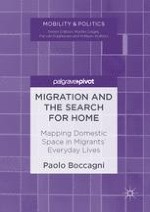2017 | Buch
Über dieses Buch
This book explores the impact of transnational migration on the views, feelings, and practices of home among migrants. Home is usually perceived as what placidly lies in the background of everyday life, yet migrants’ experience tells a different story: what happens to the notion of home, once migrants move far away from their “natural” bases and search for new ones, often under marginalized living conditions? The author analyzes in how far migrants’ sense of home relies on a dwelling place, intimate relationships, memories of the past, and aspirations for the future–and what difference these factors make in practice. Analyzing their claims, conflicts, and dilemmas, this book showcases how in the migrants’ case, the sense of home turns from an apparently intimate and domestic concern into a major public question.
Anzeige
